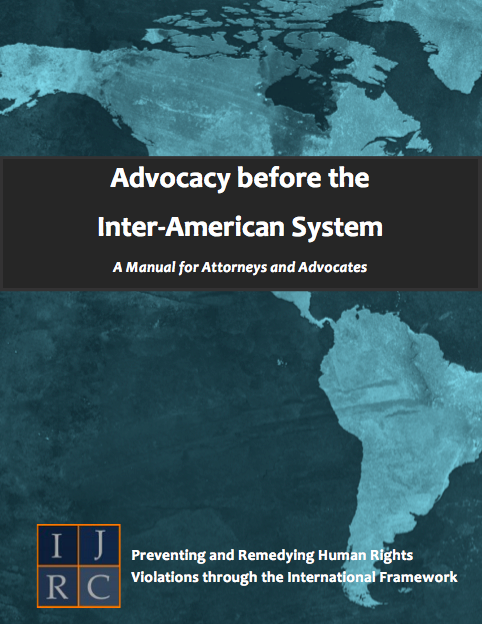
Advocacy before the Inter-American System: Manual for Attorneys and Advocates
IJRC’s publication provides detailed information on the System, its components, complaints procedure, and decisions
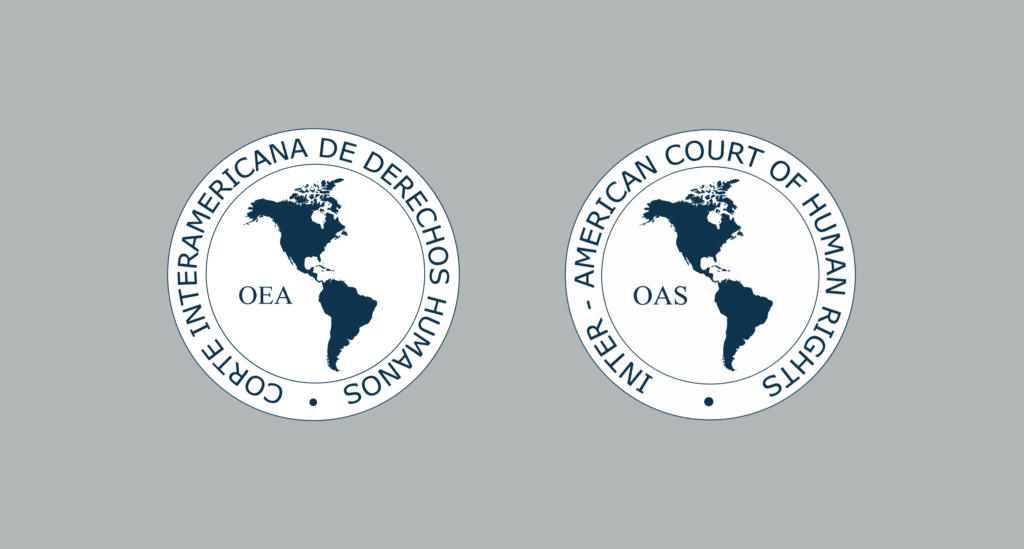
The Inter-American System for the protection of human rights is a regional human rights system, and is responsible for monitoring, promoting, and protecting human rights in the 35 independent countries of the Americas that are members of the Organization of American States (OAS).
The Inter-American System is composed of two principal entities: the Inter-American Commission on Human Rights (IACHR) and Inter-American Court of Human Rights (IACtHR). Both bodies can decide individual complaints concerning alleged human rights violations and may issue emergency protective measures when an individual or the subject of a complaint is in immediate risk of irreparable harm. The Commission also engages in a range of human rights monitoring and promotion activities (including through its various rapporteurships), while the Court may issue advisory opinions on issues pertaining to the interpretation of the Inter-American instruments at the request of an OAS organ or Member State.
Additional bodies within the Inter-American System focus on particular rights or groups. These include the Inter-American Commission of Women (CIM, by its Spanish initials), the Working Group on the Protocol of San Salvador, and the Follow-up Mechanism to the Belém do Pará Convention (MESECVI).

IJRC’s publication provides detailed information on the System, its components, complaints procedure, and decisions
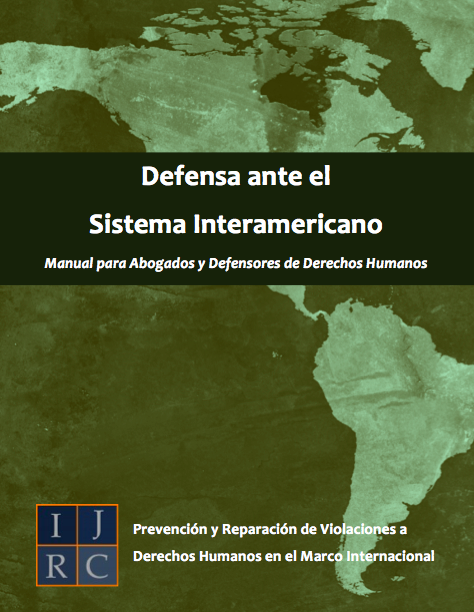
Spanish
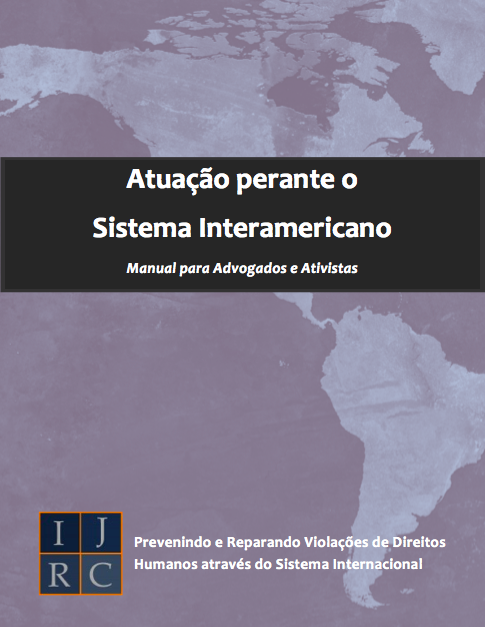
Portuguese
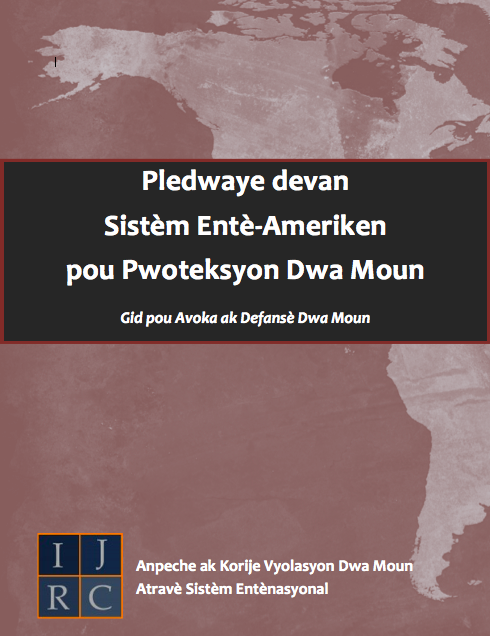
Haitian Creole
View the exhaustion guide for an overview of how the Inter-American human rights bodies interpret and apply the procedural requirement of exhaustion of domestic remedies in their complaints processes.
For quick reference, view our one-page overviews of the IACHR, IACtHR, CIM, and Working Group, as well as two-page country factsheets on each of the 35 Member States of the OAS.
Video Resources
IJRC created an informational video about the Inter-American System that is available in English, Spanish, Portuguese, and Haitian Creole that explain the Inter-American System through four animated chapters and interviews with experienced human rights defenders.
The Inter-American System for the protection of human rights is a regional human rights system, and is responsible for monitoring, promoting, and protecting human rights in the 35 independent countries of the Americas that are members of the Organization of American States (OAS).
The Inter-American System is composed of two principal entities: the Inter-American Commission on Human Rights (IACHR) and Inter-American Court of Human Rights (IACtHR). Both bodies can decide individual complaints concerning alleged human rights violations and may issue emergency protective measures when an individual or the subject of a complaint is in immediate risk of irreparable harm. The Commission also engages in a range of human rights monitoring and promotion activities (including through its various rapporteurships), while the Court may issue advisory opinions on issues pertaining to the interpretation of the Inter-American instruments at the request of an OAS organ or Member State.
Additional bodies within the Inter-American System focus on particular rights or groups. These include the Inter-American Commission of Women (CIM, by its Spanish initials), the Working Group on the Protocol of San Salvador, and the Follow-up Mechanism to the Belém do Pará Convention (MESECVI).
The explanations and resources below provide greater detail on each mechanism’s mandate and functions. Visit the IJRC News Room for articles on recent developments involving the Inter-American System.
Seat: Washington, DC Operating Since: 1960
The Inter-American Commission on Human Rights (IACHR) addresses human rights conditions and violations in the 35 Member States of the OAS. Those States are: Antigua and Barbuda, Argentina, Bahamas, Barbados, Belize, Bolivia, Brazil, Canada, Chile, Colombia, Costa Rica, Cuba, Dominica, Ecuador, El Salvador, Grenada, Guatemala, Guyana, Haiti, Honduras, Jamaica, Mexico, Nicaragua, Panama, Paraguay, Peru, Dominican Republic, Saint Kitts and Nevis, Saint Lucia, Saint Vincent and the Grenadines, Suriname, Trinidad and Tobago, United States of America, Uruguay, and Venezuela.
Established by an OAS resolution in 1959, the IACHR began operating in 1960, observing human rights conditions via on-site visits, and in 1965 was authorized to begin processing specific complaints of human rights violations. OAS Member States recognized the IACHR as the region’s principal human rights body through a protocol to the OAS Charter which was adopted in 1967 and entered into force in 1970.
The Commission is composed of seven members who are elected by the OAS Member States and who serve part-time and in their individual capacities for four-year terms that may be renewed once. The commissioners are supported by the staff of the Executive Secretariat. To read more about the commissioners and their election process, see our IACHR Composition & Election guide.
In June 2019, four seats on the Commission were filled in an election. To read about the 2019 candidates and election process, see our two-page overview.
In addition to carrying out country visits and receiving complaints, the Commission also holds thematic hearings on specific topical areas of concern, publishes studies and reports, requests the adoption of precautionary measures to protect individuals at risk, and has established several thematic rapporteurships to more closely monitor certain human rights themes or the rights of specific communities in the hemisphere.
Individuals, groups of individuals, and non-governmental organizations recognized in any OAS Member State may submit complaints (“petitions“) concerning alleged violations of the American Declaration of the Rights and Duties of Man, American Convention on Human Rights, and other regional human rights treaties (listed below). The Commission generally receives at least 2,000 petitions every year.
The Commission’s Statute and Rules of Procedure outline its structure, objectives, and procedures, although some aspects of the day-to-day processing of cases are determined by the legal staff of the Executive Secretariat.
The Commission’s website contains its published cases (reports on admissibility, merits, friendly settlements and decisions to archive), decisions on requests for precautionary measures, and applications to the Inter-American Court, in addition to its annual reports, thematic reports, and country reports. The IACHR publishes video and audio recordings of the hearings held during each Period of Sessions; these are also organized by theme.
Inter-American Commission on Human Rights began establishing rapporteurships in 1990. Rapporteurships are special mechanisms dedicated toward protecting and promoting the rights of vulnerable groups of people who have historically faced marginalization. The establishment of rapporteurships allowed the Commission to oversee human rights conditions on topics of particular concern.
As of April 2020, there are nine thematic rapporteurships, and two special rapporteurships. All of these special mechanisms gather and disseminate information on how different groups of people or different rights are being protected throughout the Organization of American States (OAS) Member States. The special mechanisms use this information to develop reports or recommendations to Member States to help them better protect and promote the human rights of their people, and to guide the Inter-American Commission on Human Rights in its decisions.
Thematic rapporteurships are generally overseen by one of the Commission’s seven Commissioners, who undertake their duties on a part-time basis. The Commission itself decides which members will be responsible for which thematic rapporteurships.
The Commission also designates country rapporteurs from among the seven Commissioners. Each Member State is assigned a country rapporteur, who is responsible for carrying out activities assigned by the Commission within that State. Thematic rapporteurs often collaborate with the country rapporteurs in conducting country visits within the Member States.
In contrast, the special rapporteurs – on freedom of expression and on economic, social, cultural, and environmental rights – are not members of the Commission. They are independent experts chosen by the Commission, and who serve on a full-time basis for a period of three years, which may be renewed once.
The rapporteurships are responsible for reporting their activities to the Commission. In turn, the Commission is tasked with presenting Annual Reports to the OAS General Assembly. In these reports, the Commission provides an account of the rapporteurships’ activities, including any reports produced and promotional activities undertaken.
As described in greater detail at the links below, each special mechanism’s capabilities are set forth in its mandate. Generally, rapporteurships and special rapporteurships may:
In 2019, the IACHR adopted Guidelines on the Activities and Functions of its two special rapporteurships.
The Commission is empowered to create rapporteurships that are dedicated to areas of special interest, in order to promote and protect the human rights of vulnerable groups throughout the Americas. See Rules of Procedure of the Inter-American Commission on Human Rights, art. 15. To create a rapporteurship, the majority of the Commission’s members must adopt a resolution. The resolution must delineate the functions and scope of the mandate, provide a description of the activities to be carried out, and an accounting of how these activities will be financed. See id.
Thematic rapporteurships are allocated among the seven Commissioners. The rapporteurships usually are designated during the first session of the Commission, but appointments may be made whenever necessary. Thematic rapporteurs undertake their duties on a part-time basis for a three-year term, which may be renewed once. See id.
To elect a special rapporteur, the Commission must publicize the position, which allows individuals who are not members of the Commission to apply. The Commission then accepts comments from OAS Member States and civil society regarding the final candidates, and ultimately reaches a majority vote to elect the rapporteur. The Commission is required to publish the grounds for its decision. Special rapporteurs have a duty to disclose any potential conflicts of interest they have with the position, and the Commission has the ability to replace a rapporteur for reasonable cause. Special rapporteurs serve for three-year terms in a full-time capacity unless the mandate terminates earlier, and may renew their term once. See id.
The following 11 rapporteurships have been established:
Seat: San José, Costa Rica Operating Since: 1979
The Inter-American Court of Human Rights is the judicial organ of the Inter-American human rights system. The Court’s mandate is more limited than that of the Commission because the Court may only decide cases brought against the OAS Member States that have specifically accepted the Court’s contentious jurisdiction and those cases must first be processed by the Commission. Additionally, only States parties and the Commission may refer contentious cases to the Court.
The seven judges of the Court are independent, but are chosen by States through the OAS General Assembly. Judges are elected for a six-year term, once renewable. The Court and its judges convene several times per year for sessions lasting up to two weeks, but its staff works year-round. To read more about the judges and their election process, see our IACtHR Composition & Election guide.
As of January 2021, 24 OAS Member States are States parties to the American Convention on Human Rights, and 20 have opted to accept the Court’s contentious jurisdiction in accordance with Article 62 of the American Convention. The 20 States over which the Court may exercise its contentious jurisdiction are: Argentina, Barbados, Bolivia, Brazil, Chile, Colombia, Costa Rica, Dominican Republic, Ecuador, El Salvador, Guatemala, Haiti, Honduras, Mexico, Nicaragua, Panama, Paraguay, Peru, Suriname, and Uruguay. Previously, Trinidad and Tobago and Venezuela had both accepted the Court’s jurisdiction, but withdrew from that jurisdiction when they denounced the American Convention, in 1998 and 2012, respectively. The OAS recognized Venezuela’s ratification of the American Convention by opposition leader Juan Guaidó in 2019.
The Court began operating in 1979, and soon issued several advisory opinions, but did not begin exercising its contentious jurisdiction until 1986, when the Commission submitted the first contentious case: Velasquez Rodriguez v. Honduras, regarding which the Court issued a judgment on the merits in 1988.
Over the Court’s first several decades in operation, its annual case load has more than doubled; many more States have found themselves before the Court; and the Court has adjudicated a significant range of rights protected by the American Convention and ancillary agreements, from extrajudicial execution and forced disappearance cases, to labor, land, and freedom of expression rights.
The Court’s Statute and Rules of Procedure outline its structure, objectives, and procedures.
View the Court’s judgments, as well as its annual reports and other publications on its website. Videos of the Court’s hearings are available on its Vimeo page. The Audio Library of the Court, which includes audio files of the public hearings that have been held in the 40 years of the Court’s existence, can be accessed via Soundcloud.
Seat: Washington, DC Operating Since: 1928
The Inter-American Commission of Women (CIM, or la Comisión Interamericana de Mujeres, in Spanish) is a specialized inter-governmental agency within the Organization of American States (OAS). CIM is the only hemisphere-wide policy forum on women’s rights and gender equality in the Americas. Its counterpart, the CIM Executive Committee, complements its work and meets more regularly to discuss routine matters and immediate concerns. CIM is based at the OAS headquarters in Washington, District of Columbia, United States.
The Working Group on the Protocol of San Salvador is an intergovernmental monitoring body which oversees implementation of the Protocol of San Salvador, an additional and optional protocol to the American Convention on Human Rights that enshrines social, economic, and cultural rights. The Working Group functions in the framework of the Inter-American Council for Integral Development. Pursuant to resolution AG/RES. 2262 (XXXVII-O/07), adopted on June 5, 2007, the Working Group is tasked with monitoring the implementation of the Protocol of San Salvador, and examining the periodic reports that States parties are required to submit.
The Follow-up Mechanism to the Belém do Pará Convention (MESECVI) is a specialized intergovernmental entity within the OAS, charged with assisting States parties in their implementation of the Inter-American Convention on the Prevention, Punishment, and Eradication of Violence against Women (Belém do Pará Convention). As of April 2020, there are 32 States parties to the Belém do Pará Convention: Antigua and Barbuda, Argentina, Bahamas, Barbados, Belize, Bolivia, Brazil, Chile, Colombia, Costa Rica, Dominica, Dominican Republic, Ecuador, El Salvador, Grenada, Guatemala, Guyana, Haiti, Honduras, Jamaica, Mexico, Nicaragua, Panama, Paraguay, Peru, Saint Kitts and Nevis, Saint Lucia, Saint Vincent and the Grenadines, Suriname, Trinidad and Tobago, Uruguay, and Venezuela.
The Caribbean Court of Justice (CCJ) settles disputes between Caribbean Community (CARICOM) Member States, and also serves as the highest court of appeals on civil and criminal matters for the national courts of Barbados, Belize and Guyana. The CCJ’s seat is in Port of Spain, Trinidad and Tobago. The Caribbean Court of Justice does not have competence to hear individual complaints of alleged human rights violations, except in its capacity as a court of final appeal in civil and criminal matters, which often involve fundamental rights.
More detailed information about the CCJ.
The Central American Court of Justice (Corte Centroamericana de Justicia) is an international tribunal of general jurisdiction, created in the interest of promoting peace and regional unity, under the auspices of the Central American Integration System. The Central American Court of Justice sits in Managua, Nicaragua and has four Member States: Guatemala, Honduras, El Salvador and Nicaragua. The Court of Justice does not have competence to hear individual complaints of alleged violations of the American Convention of Human Rights.
More detailed information about the Central American Court of Justice.
The Court of Justice of the Andean Community (Tribunal de Justicia de la Comunidad Andina (TJCA)) settles disputes between Andean Community Member States that arise under Community law. The TJAC is seated in Quito, Ecuador and serves the Community’s four Member States: Bolivia, Colombia, Ecuador and Peru. The Court of Justice of the Andean Community does not have competence to hear individual complaints of alleged human rights violations, but individuals can bring claims to determine whether States are in compliance with trade-related obligations to respect the rights of certain groups.
More detailed information about the Central of Justice of the Andean Community.
The Court and Commission’s human rights promotion work is complemented by the Inter-American Institute of Human Rights, an autonomous research and educational institution based in San José, Costa Rica. The Institute (best known by its Spanish acronym “IIDH”) provides free online courses on various human rights topics, publishes numerous books, operates a Digital Library (navigation in Spanish), moderates a discussion listserve, and organizes seminars and workshops for civil society throughout the Americas. In addition to its online resources, the Institute is open to visitors seeking research assistance, use of the physical library, or to purchase publications.
The Commission and Court are charged with interpreting and applying a number of regional human rights instruments, which include the:
Additionally, the following documents guide the Court and Commission’s interpretation of the above instruments:
IJRC’s informational video explains the Inter-American System through four animated chapters and interviews with experienced human rights defenders. These videos are also available in Spanish, Portuguese, and Haitian Creole language versions, and may be downloaded free of charge on Vimeo or YouTube.
Use the Video Guide to follow along.
1. What is the Inter-American System?
2. What Rights Are Protected?
3. How to Present a Petition
4. How the Commission Processes Petitions
5. Insights from Practitioners
Stay informed by subscribing to one or both of our mailing lists:
CGLJ News and CGLJ Resource Hub Newsroom!